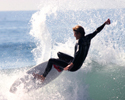Stringer
What's In A Stringer?
 The stringer is one of the central areas of surfboard design to which the shaping community is paying increased attention. While it has always been commonplace to see wooden stringers running down the center of a foam blank, shapers have reevaluated the stringer’s function to further advance the sport.
The stringer is one of the central areas of surfboard design to which the shaping community is paying increased attention. While it has always been commonplace to see wooden stringers running down the center of a foam blank, shapers have reevaluated the stringer’s function to further advance the sport.
When Clark Foam ceased operations in December 2005 it signaled the beginning of a revolution in surfboard design and technology. While many pioneers ventured into the unknown waters of different materials and design before Grubby Clark shut his company’s doors, it took this large splash to send ripples into every corner of the sport. This revolution has produced an era of accepted innovation. Never in the history of modern surfing have we seen such a consistent effort to improve board performance and strength through design and material experimentation. The following are common stringer designs.
Center Stringer
The stringer is the thin strip of wood that traditionally runs down the middle of the surfboard. The wood is typically made of balsa and the thickness increases the strength and rigidity of the board. Some boards have multiple stringers for added stiffness.
Parabolic Stringers
The stringer system in which two stringers wrap the perimeter of the rails. They are typically made with balsa material, but shapers recently introduced carbon fiber as a new material used for parabolic stringers. The desired function behind parabolic stringers is memory flex, which dictates how quickly the shape can bend and bounce back to its original shape. A balance of strength and flex must be found because flex is useless without the element of strength. In traditional center stringers, there is torsion flex, meaning the perimeters flex and twist. This will cause the board to slow and fatigue. With a strengthened perimeter, the surfer can apply a more controlled weight to the board’s rail, thus gaining more controlled buoyancy. This enhances drive, improves wave face penetration and increases speed. The added flexibility on the perimeter of the board allows you to lean into the stringer in turns as apposed to the foam. This bends the stringer and shoots you out of the turn as it flexes back. That means more speed, acceleration and torque through each turn.
Multiple Stringers
Often times, longboards have multiple stringers for the purpose of adding strength. This is sometimes needed because the larger surface area of a longboard can flex and wobble too much. Additional stringers will minimize this effect.
Stringerless
Some surfboards have no stringers. Epoxy and Carbon Fiber boards often have a stringerless design. Their materials and sandwich construction give the board added stiffness so a stringer is not needed.















0 Comments